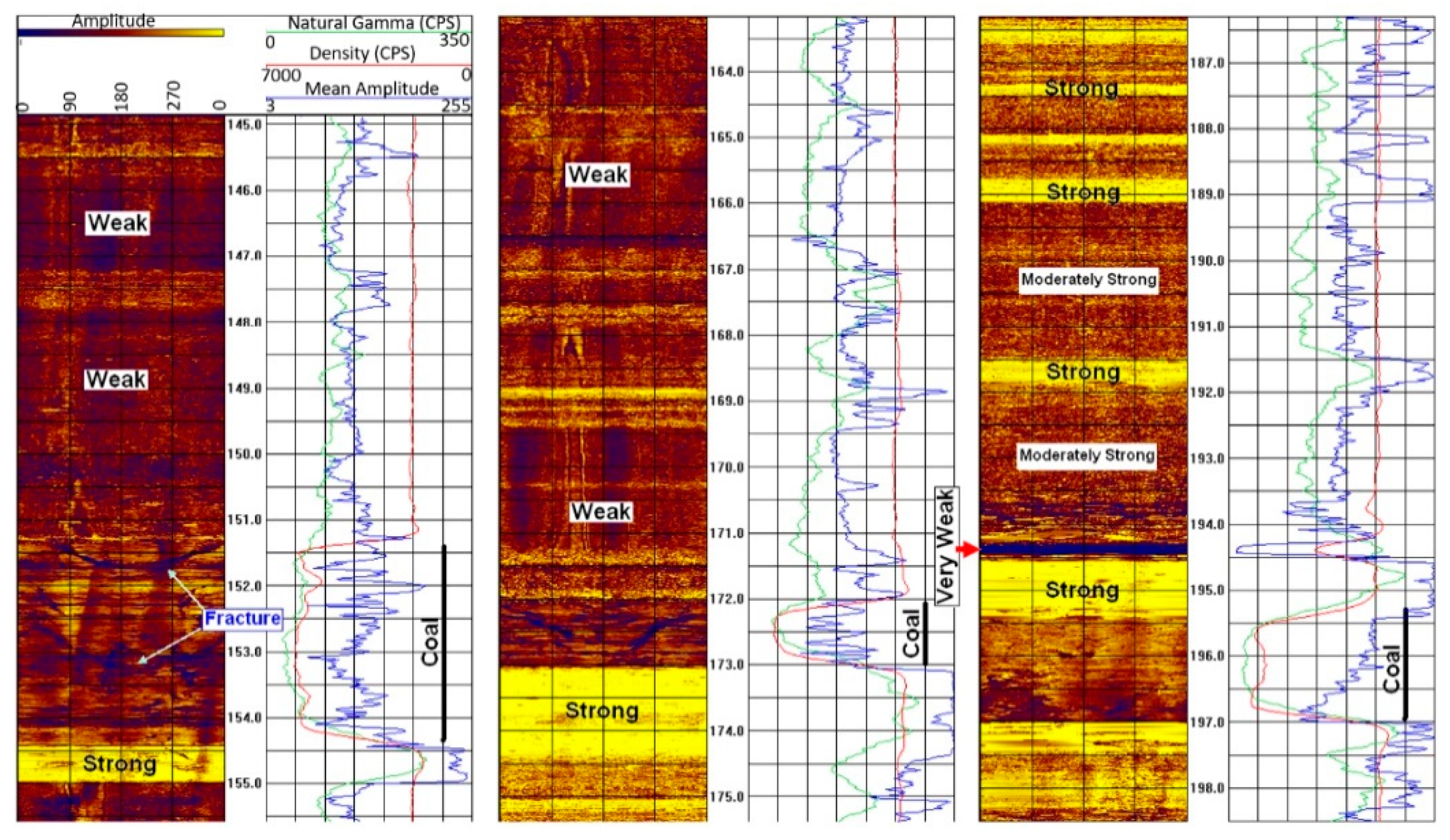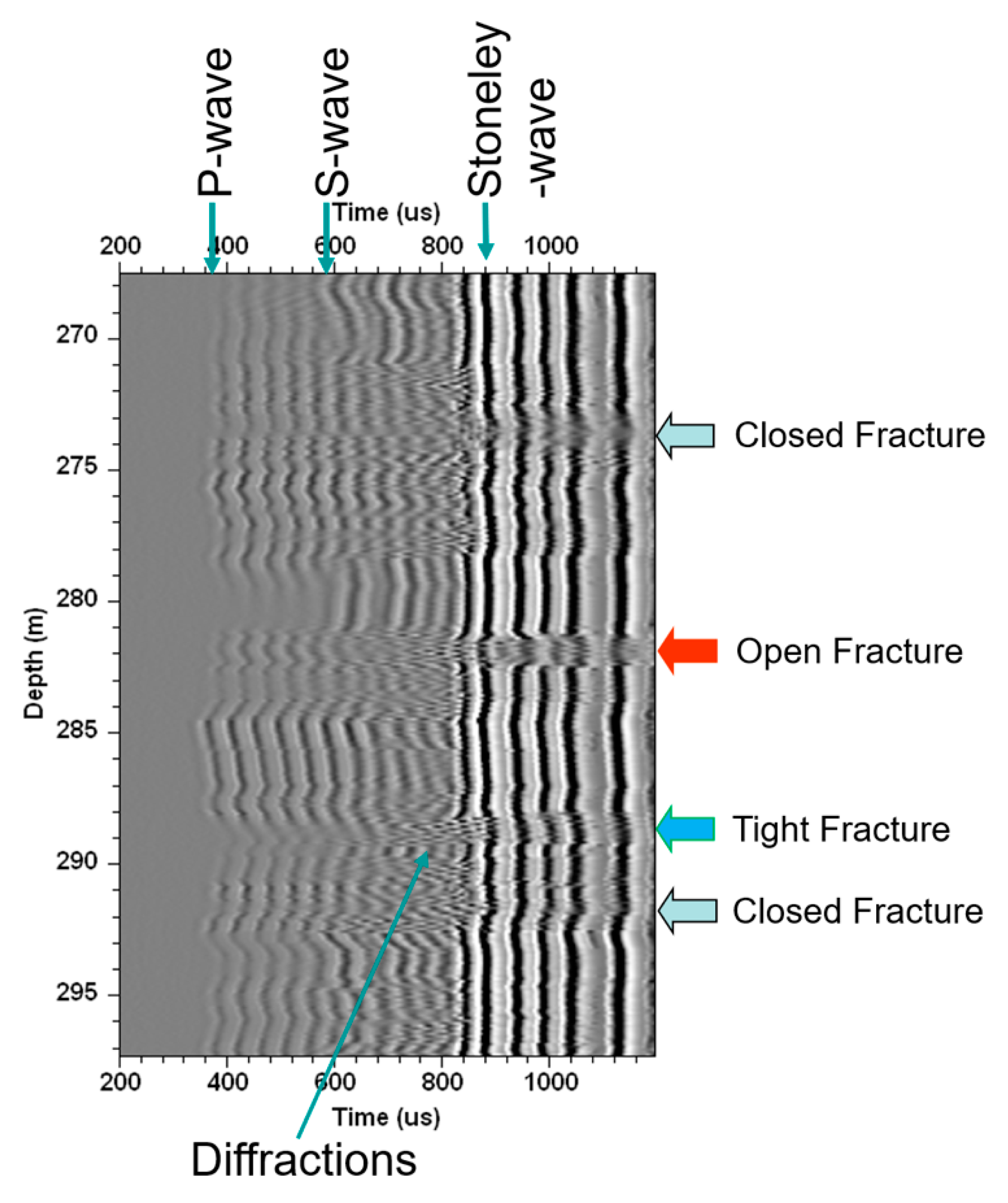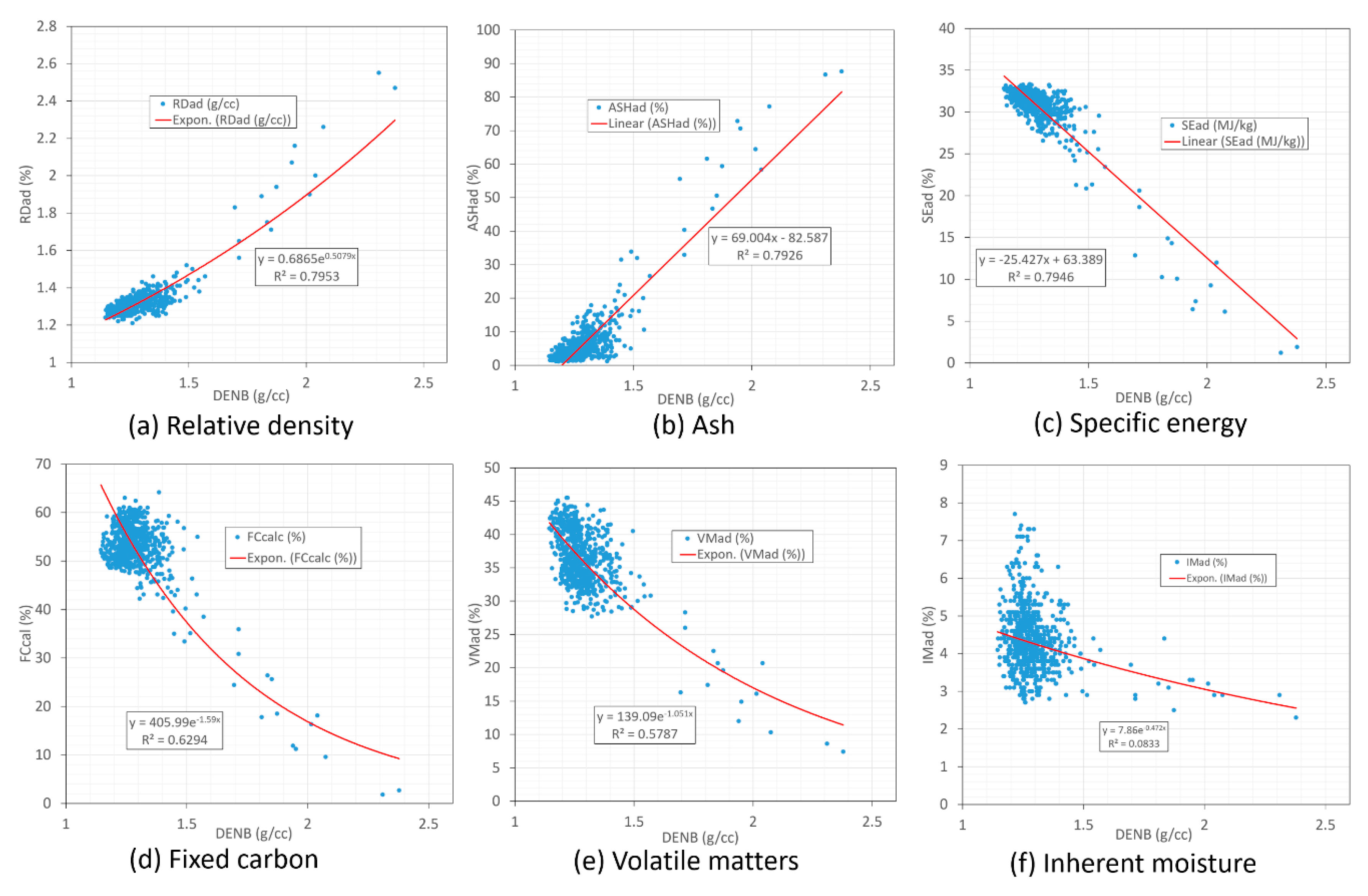Applications of Geophysical Logs to Coal Mining—Some Illustrative Examples
Abstract
:1. Introduction
2. Geotechnical Characterization from Geophysical Logs
2.1. Sonic Log and Uniaxial Compressive Strength
2.1.1. UCS Estimation from Acoustic Logs–the McNally Method
2.1.2. Rock Strength Evaluation from Acoustic Scanner Logs
2.1.3. Rock Integrity Assessment from Full-Waveform Sonic Data
2.2. Geophysical Strata Rating
2.3. 2D/3D Modelling of Geophysical Logs for Strata Geotechnical Characterization
2.4. Automated Lithology Interpretation: Identification of Sugar Sands
2.5. Automated Geological and Geotechnical Interpretation
3. Coal Quality Estimation from Geophysical Logs
4. Conclusions
Author Contributions
Funding
Acknowledgments
Conflicts of Interest
References
- Kayal, J.R. Electrical and gamma-ray logging in Gondwana and Tertiary coalfields of India. Geol. Explor. 1979, 17, 243–258. [Google Scholar]
- Hofman, G.L.; Jordan, G.R.; Wallis, G.R. Geophysical Borehole Logging Handbook for Coal Exploration; The Coal Mining Research Centre: Edmonton, Alberta, 1982; ISBN 0969104804. [Google Scholar]
- Hatherly, P.J. Overview on the application of geophysics in coal mining. Int. J. Coal Geol. 2013, 114, 74–84. [Google Scholar] [CrossRef]
- Fullagar, P.K.; Fallon, G.N. Geophysics in metalliferous mines for orebody delineation and rock mass characterization. In Proceedings of the Exploration’97—Fourth Decennial International Conference on Mineral Exploration, Toronto, ON, Canada, 14–18 September 1997; Gubins, A.G., Ed.; pp. 573–584. [Google Scholar]
- Fullagar, P.K.; Zhou, B.; Fallon, G.N. Automated interpretation of geophysical borehole logs for orebody delineation and grade estimation. Miner. Resour. Eng. 1999, 8, 269–284. [Google Scholar] [CrossRef]
- Fallon, G.; Fullagar, P.K.; Zhou, B. Towards grade estimation via automated interpretation of geophysical borehole logs. Explor. Geophys. 2000, 31, 236–242. [Google Scholar] [CrossRef]
- Zhou, B.; O’Brien, G. Improving coal quality estimation through multiple geophysical log analysis. Int. J. Coal Geol. 2016, 167, 75–92. [Google Scholar] [CrossRef]
- McNally, G.H. The prediction of geotechnical rock properties from sonic and neutron logs. Explor. Geophys. 1990, 21, 65–71. [Google Scholar] [CrossRef]
- Guo, H.; Zhou, B.; Poulsen, B.; Biggs, M. 3D overburden geotechnical characterization for longwall mining at Southern Colliery. In Proceedings of the Bowen Basin Symposium, Rockhampton, Queensland, Australia, 22–24 October 2000; pp. 67–72. [Google Scholar]
- Zhou, B.; Guo, H.; Hatherly, P.; Poulsen, B. Automated geotechnical characterisation from geophysical logs: Examples from Southern Colliery, Central Queensland. Explor. Geophys. 2001, 32, 336–339. [Google Scholar] [CrossRef]
- Zhou, B.; Fraser, S.; Borsaru, M.; Aizawa, T.; Sliwa, R.; Hashimoto, T. New approaches for rock strength estimation from geophysical logs. In Proceedings of the Bowen Basin Symposium, Yeppoon, Queensland, Australia, 12–14 October 2005; pp. 151–164. [Google Scholar]
- Hatherly, P. Rock Strength Assessment from Geophysical Logging. In Proceedings of the 8th International Symposium on Borehole Geophysics for Minerals, Geotechnical and Groundwater Applications, Toronto, ON, Canada, 21–23 August 2002. [Google Scholar]
- Medhurst, T.; Hatherly, P.; Zhou, B. 3D geotechnical models for coal and clastic rocks based on the GSR. In Proceedings of the 2002 Coal Operators’ Conference, Wollongong, Australia, 11–12 February 2010. [Google Scholar]
- Guo, H.; Zhou, B. Geotechnical characterisation from geophysical logs for longwall coal mining. In Proceedings of the 73rd EAGE Conference & Exhibition incorporating SPE EUROPEC 2011, Vienna, Austria, 23–26 May 2011. [Google Scholar]
- Kitzig, M.C.; Kepic, A.; Kieu, D.T. Testing cluster analysis on combined petrophysical and geochemical data for rock mass classification. Explor. Geophys. 2017, 48, 344–352. [Google Scholar] [CrossRef] [Green Version]
- Schön, J.H. Physical Properties of Rocks: Fundamentals and Principles of Petrophysics, 2nd ed.; Elsevier Science Ltd.: Amsterdam, The Netherlands, 2015. [Google Scholar]
- Lawrence, W. Interpreting and understanding strata behaviour. In Proceedings of the 2nd Annual Longwall Mining Summit, Yeppoon, Australia, 25–26 February 1999. [Google Scholar]
- Ward, B. German Creek Mines Rock strength from velocity logs. 1988; Unpublished report for Capricorn Coal Management Pty Ltd. [Google Scholar]
- Turvey, C.; Hanna, P. Coal Geology—Where to from here? In Proceedings of the 1998 Coal Operators’ Conference, Wollongong, Australia, 18–20 February 1998; pp. 126–132. [Google Scholar]
- Payne, D.A. Crinum Mine, 15 Longwalls 40 Million Tonnes 45 Roof Falls-What did we learn? In Proceedings of the 2008 Coal Operators’ Conference, Wollongong, Australia, 14–15 February 2008; Aziz, N., Ed.; University of Wollongong: Wollongong, Australia, 2008; pp. 22–43. [Google Scholar]
- Stam, S.; Guy, G.; Gordon, N. Back analysis of roof classification and roof support systems at Kestrel North. In Proceedings of the 2012 Coal Operators’ Conference, Wollongong, Australia, 16–17 February 2012; pp. 42–51. [Google Scholar]
- Pell, S.; Seedsman, R.; Straub, K. Geotechnical data from geophysical logs: Stress, strength and joint patters in NSW and QLD coalfields. In Proceedings of the 2014 Coal Operators’ Conference, Wollongong, Australia, 12–14 February 2014; pp. 25–33. [Google Scholar]
- Oyler, D.C.; Mark, C.; Molinda, G.M. In situ estimation of rock strength using sonic logging. Int. J. Coal Geol. 2010, 83, 484–490. [Google Scholar] [CrossRef]
- Rao, M.S.; Bhaskar, G.U.; Karekal, S. Estimation of Uniaxial Compressive Strength of Coal Measures of Pranhita-Godavari Valley, India Using Sonic Logs. In Proceedings of the 2015 Coal Operators’ Conference, Wollongong, Australia, 11–13 February 2015; pp. 36–47. [Google Scholar]
- MacGregor, S. Maximising In-Situ Stress Measurement Data from Borehole Breakout using Acoustic Scanner and Wireline Tools; Final Report for ACARP Project C1009; ACARP: Brisbane, Australia, 2003. [Google Scholar]
- Chang, C. Empirical rock strength logging in boreholes penetrating sedimentary formations. Geol. Earth Environ. Sci. 2004, 7, 174–183. [Google Scholar]
- Hatherly, P.; Sliwa, R.; Turner, R.; Medhurst, T. Quantitative Geophysical Log Interpretation for Rock Mass Characterization; Final Report ACARP Project C11037; ACARP: Brisbane, Australia, 2003. [Google Scholar]
- Hatherly, P.; Medhurst, T. MacGregor. Geophysical Strata Rating; Final Report ACARP Project C15019; ACARP: Brisbane, Australia, 2008. [Google Scholar]
- Molinda, G.M.; Mark, C. Coal mine roof rating (CMRR). In A Practical Rock Mass Classification for Coal Mines 9387; United States Department of the Interior, Bureau of Mines, Information Circular: Pittsburgh, PA, USA, 1994; p. 34. [Google Scholar]
- Bieniawski, Z.T. Engineering Rock Classifications, a Complete Manual for Engineers and Geologists in Mining, Civil and Petroleum Engineering; Wiley: New York, NY, USA, 1989. [Google Scholar]
- Hatherly, P.; Medhurst, T.; Zhou, B. Geotechnical evaluation of coal deposits based on the Geophysical Strata Rating. Int. J. Coal Geol. 2016, 163, 72–86. [Google Scholar] [CrossRef]
- Medhurst, T.; Hatherly, P.; Zhou, B.; Ye, G. Application of the Geophysical Strata Rating in Production Settings; Final Report for ACARP Project C17009; ACARP: Brisbane, Australia, 2009. [Google Scholar]
- Borsaru, M.; Zhou, B.; Aizawa, T.; Karashima, T.; Hashimoto, H. Automated lithology prediction from PGNAA and other geophysical logs. Appl. Radiat. Isot. 2006, 64, 272–282. [Google Scholar] [CrossRef]
- Edwards, K.W.; Banks, K.M. A theoretical approach to the evaluation of in-situ coal. Can. Min. Metall. Bull. 1978, 71, 124–131. [Google Scholar]
- Borsaru, M.; Charbicinski, J.; Rojc, A.; Thanh, N.D.; Tuy, N.T. Probe for determination of ash in coal stockpiles. Nucl. Instrum. Methods Phys. Res. 2004, 213, 422–425. [Google Scholar] [CrossRef]
- Dong, H.; Hou, J.; Li, N.; Wang, H. The logging evaluation method for coal quality and methane. Geophys. Geochem. Explor. 2001, 25, 138–143. [Google Scholar]
- Zhou, B.; Esterle, J. Toward improved coal density estimation from geophysical logs. Explor. Geophys. 2008, 39, 124–132. [Google Scholar] [CrossRef]
- Borsaru, M.; Ceravolo, C. A low activity spectrometric gamma-gamma borehole logging tool for the coal industry. Nucl. Geophys. 1994, 8, 343–350. [Google Scholar]
- Charbucinski, J.; Nichols, W. Application of spectrometric nuclear borehole logging for reserves estimation and mine planning at Callide coalfields open-cut mine. Appl. Energy 2003, 74, 313–322. [Google Scholar] [CrossRef]




















| Depth from | Depth to | Fracture Description |
|---|---|---|
| 250.5 | 253.6 | Closed fractures |
| 257 | 258 | Open fractures |
| 273 | 274.5 | Open fractures |
| 288.16 | 289 | Tight fractures |
| 289.9 | 292.5 | Tight fractures in Siltstone |
| 304 | 305.6 | Closed fractures |
| 312 | 312.8 | Closed fractures |
| 316.9 | 317.9 | Closed fractures |
| 323.6 | 324.8 | Closed Fractures |
| 326.3 | 328.4 | Closed Fractures |
| 337.3 | 339.7 | Closed Fractures |
| 350.6 | 355 | Closed Fractures |
| 372.45 | 373.5 | Tight fractures |
| 393.45 | 395.75 | Closed fractures |
| 411.2 | 413.7 | Tight fractures |
| 416.3 | 417.3 | Closed fractures |
| 419.4 | 420.1 | Closed fractures |
| 421.9 | 423.2 | Closed fractures |
| 424.4 | 428.5 | Closed fractures |
| Average Value | Min. Error | Max. Error | Average Error | Average Error in % | Correlation R | |
|---|---|---|---|---|---|---|
| RD (g/cc) | 1.33 | 0.00 | 0.33 | 0.03 | 2.23 | 0.87 |
| Ash (%) | 6.56 | 0.00 | 21.54 | 3.03 | 71.21 | 0.88 |
| Specific Energy (MJ/kg) | 30.54 | 0.00 | 7.67 | 1.13 | 4.73 | 0.86 |
| Fixed carbon (%) | 52.90 | 0.00 | 20.18 | 4.85 | 10.41 | 0.56 |
| Volatile Matter (%) | 36.19 | 0.01 | 11.62 | 3.01 | 8.59 | 0.64 |
| Inherent Moisture (%) | 4.35 | 0.00 | 3.27 | 0.64 | 14.74 | 0.26 |
| Average Value | Min. Error | Max. Error | Average Error | Average Error (%) | Correlation R | |
|---|---|---|---|---|---|---|
| RD (g/cc) | 1.33 | 0.00 | 0.27 | 0.03 | 2.16 | 0.92 |
| Ash (%) | 6.56 | 0.00 | 18.48 | 2.48 | 52.20 | 0.95 |
| Specific Energy (MJ/kg) | 30.54 | 0.00 | 7.01 | 1.04 | 4.42 | 0.89 |
| Fixed carbon (%) | 52.90 | 0.01 | 19.33 | 2.29 | 7.09 | 0.71 |
| Volatile Matter (%) | 36.19 | 0.01 | 9.50 | 2.54 | 7.32 | 0.74 |
| Inherent Moisture (%) | 4.35 | 0.00 | 3.09 | 0.56 | 13.00 | 0.51 |
© 2020 by the authors. Licensee MDPI, Basel, Switzerland. This article is an open access article distributed under the terms and conditions of the Creative Commons Attribution (CC BY) license (http://creativecommons.org/licenses/by/4.0/).
Share and Cite
Zhou, B.; Guo, H. Applications of Geophysical Logs to Coal Mining—Some Illustrative Examples. Resources 2020, 9, 11. https://doi.org/10.3390/resources9020011
Zhou B, Guo H. Applications of Geophysical Logs to Coal Mining—Some Illustrative Examples. Resources. 2020; 9(2):11. https://doi.org/10.3390/resources9020011
Chicago/Turabian StyleZhou, Binzhong, and Hua Guo. 2020. "Applications of Geophysical Logs to Coal Mining—Some Illustrative Examples" Resources 9, no. 2: 11. https://doi.org/10.3390/resources9020011





